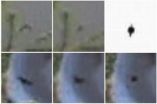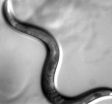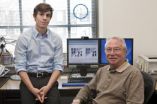(Press-News.org) Dr. Michael Collins, Naval Research Laboratory scientist and bird watcher, has published an article titled "Putative audio recordings of the Ivory-billed Woodpecker (Campephilus principalis)" which appears in the March issue of the Journal of the Acoustical Society of America. The audio recordings were captured in two videos of birds with characteristics consistent with the Ivory-billed Woodpecker. This footage was obtained near the Pearl River in Louisiana, where there is a history of unconfirmed reports of this species. During five years of fieldwork, Collins had ten sightings and also heard the characteristic "kent" calls of this species on two occasions. Scientists working independently in three states have now published articles that report multiple sightings of and various forms of evidence for this elusive species, which is extremely difficult to observe and photograph due to its rarity, wariness, and tendency to roam over wide areas in remote swamp habitat. The two previous articles present findings from Arkansas [Fitzpatrick et al., Science (2005)] and Florida [Hill et al., Avian Conservation and Ecology (2006)].
During two encounters with an Ivory-billed Woodpecker, Collins heard high-pitched calls that seem to match the description of an alarm call that was reported by James Tanner in the 1930s but was never recorded. On both occasions, the calls came from the direction of the bird and began at a moment when the bird was alarmed. Several of these calls were captured in the first video, which received a positive assessment from an independent expert, Julie Zickefoose, whose paintings of Ivory-billed Woodpeckers have appeared on the covers of a leading ornithology journal and the leading contemporary text on this species. According to Zickefoose, the large woodpecker in the video has a large crest, large bill, long neck, and rared-back posture consistent with an Ivory-billed Woodepecker, and it has ponderous and heavy flaps and takes an unusual flapping leap that is unlike anything she has seen from a Pileated Woodpecker (the only other large woodpecker in Louisiana).
The second video shows a bird in flight with flaps that are radically different from the duck-like flaps that were expected, but a long overlooked clue in a photo from 1939 suggests that there had been a misconception about the flap style. The combination of the flap style and the size rule out all species native to Louisiana other than the two large woodpeckers, but several characteristics rule out Pileated Woodpecker. This footage was obtained when an Ivory-billed Woodpecker flew along the bayou below a tall tree that was used as an observation platform, providing a view from an advantageous perspective of the white stripes on the back and the white patches on the wings. A little over a minute before the bird flew into view, the video captured a putative double knock that matches a putative double knock that was recorded by Hill et al. in Florida.
Collins began searching for Ivory-billed Woodpeckers in November 2005, shortly after Hurricane Katrina passed through the Pearl River. His first sighting was on February 2, 2006, and then two weeks later he discovered a "hot zone" a short distance up the same bayou, where he had five sightings (two of exceptional quality) and also heard the characteristic "kent" calls of this species on two occasions (once coming simultaneously from two directions) during a five-day period. The first video was obtained in the "hot zone" on February 20, 2006.
During the summer of 2007, Collins started climbing tall cypress trees to watch for Ivory-billed Woodpeckers flying over the treetops in the distance. The idea was to increase the encounter rate by opening up a larger field of view. Professor Steve Sillett, of Humboldt State University, and his colleagues, Jim Spickler and Michael Taylor, donated their expertise and time as well as a full set of gear for climbing trees. The approach provided results less than a year later, but not as expected. On March 29, 2008, an Ivory-billed Woodpecker flew directly beneath one of the observation trees, and Collins saw the definitive white stripes on the back and white trailing edges of the dorsal surfaces of the wings. Just over a minute before the bird flew into view, the camera recorded a putative double knock that is consistent with a putative double knock that was recorded in Florida.
Based on historical accounts of a duck-like flight, the Ivory-billed Woodpecker was thought to have duck-like flaps in which the wings remain extended throughout the flap cycle. Although definitive fieldmarks were observed in the field, there seemed to be a contradiction when the video was inspected and found to reveal a flap style that is radically different from what was expected -- the wings are folded completely closed in the middle of each upstroke. This mystery was resolved by a long overlooked clue, a photo from 1939 of an Ivory-billed Woodpecker in flight with the wings folded closed. The observed flap style makes sense in hindsight since it is similar to that of other large woodpeckers.
The flyunder video provides the first putative footage of an Ivory-billed Woodpecker in cruising flight. Since the bird and its reflection from the still surface of a bayou are visible, it is possible to pin down the bird's position (which can't always be deduced from video footage) by triangulation. Since the bird was initially flying nearly directly toward the camera, it was possible to simultaneously extract from the video curves that define both components (horizontal and vertical) of the wingtip motion. Since the bird flew past reference objects, it was possible to estimate wingspan and obtain the first putative data on the flight speed of this species. The video also provides the first putative data on the flap rate. The combination of the wingspan and the flap style rule out all species native to Louisiana except the two large woodpeckers, and in fact an expert on the flight mechanics of woodpeckers, Professor Bret Tobalske, of the University of Montana, is "confident it is a large woodpecker." The Pileated Woodpecker is ruled out by the narrow wing shape, high flight speed, high flap rate, and large white patches on the wings, all of which are consistent with Ivory-billed Woodpecker. The video also shows a trace of white on the back/neck that is consistent with the dorsal stripes that were observed in the field.
INFORMATION:
(Note: Dr. Collins works as a researcher at the Naval Research Laboratory-Stennis Space Center in Mississippi, and is a bird watcher. He conducts his research related to the ivory-billed woodpecker in his spare time.)
Dr. Michael Collins publishes paper on ivory-billed woodpecker
2011-04-29
ELSE PRESS RELEASES FROM THIS DATE:
New insight into chromosome segregation: Centromere-independent kinetochore assembly
2011-04-29
One of the most critical tasks that a dividing cell must accomplish is the successful delivery of a complete set of genetic information to each new daughter cell. Now, a study published by Cell Press in the April 29th issue of the journal Cell, provides fascinating new insight into the complex of proteins that orchestrates the proper segregation of human chromosomes during cell division.
During the process of mitosis, DNA and its associated packing proteins are arranged into structures called chromosomes that are duplicated and then segregated. Duplicated chromosomes ...
Nanotechnologists must take lessons from nature
2011-04-29
It's common knowledge that the perfect is the enemy of the good, but in the nanoscale world, perfection can act as the enemy of the best.
In the workaday world, engineers and scientists go to great lengths to make the devices we use as perfect as possible. When we flip on a light switch or turn the key on the car, we expect the lights to come on and the engine to start every time, with only rare exceptions. They have done so by using a top-down design process combined with the application of large amounts of energy to increase reliability by suppressing natural variability.
However, ...
Era of canopy crane ending; certain research and education activities remain
2011-04-29
The 25-story construction crane used since 1995 to investigate such things as how Pacific Northwest forests absorb carbon dioxide, obtain sufficient water and resist attacks by pests and diseases is being pruned back to just the tower.
The Wind River Canopy Crane, located in a 500-year-old forest near Stevenson in southwest Washington, has been operated cooperatively by the University of Washington, the Forest Service's Pacific Northwest Research Station and the Gifford Pinchot National Forest. The partners say the jib – the arm of the crane – is being removed because ...
Pediatric flu vaccination: Understanding low acceptance rates could help increase coverage
2011-04-29
A study of H1N1 and seasonal influenza vaccination in a sample of black and Hispanic children in Atlanta found a low rate of vaccine acceptance among parents and caregivers. Only 36 percent of parents and caregivers indicated they would immunize children against H1N1, and 22 percent indicated their children received the seasonal influenza vaccine in the previous three months. The majority of children in the sample (71 percent) were from households with less than $40,000 in annual income.
Researchers say this low level of vaccine coverage and acceptance highlights the ...
As the worm turns, its secrets are revealed
2011-04-29
An international team of scientists, led by researchers at the University of California, San Diego School of Medicine, have developed a new method for discerning the functions of previously uncharacterized genes and placing them in interactive, functional networks that reveal how gene products interact to bring about cellular events.
The research is published in the April 29 issue of the journal Cell. It was led by principal investigators Karen Oegema, PhD, professor of cellular and molecular medicine and head of the Laboratory of Mitotic Mechanisms in the Ludwig Institute ...
From the beginning, the brain knows the difference between night and day
2011-04-29
The brain is apparently programmed from birth to develop the ability to determine sunrise and sunset, new research on circadian rhythms at the University of Chicago shows.
The research sheds new light on brain plasticity and may explain some basic human behaviors, according to Brian Prendergast, associate professor in psychology at the University of Chicago and co-author of a paper published April 27 in the journal PLoS One. The lead author is August Kampf-Lassin, an advanced graduate student at the University.
"This finding may show us why infants of many species eventually ...
Get The Labels You Adore For Prices You Love at TK Maxx Crewe
2011-04-29
The long-awaited TK Maxx store is nearly ready to open its doors at the Grand Junction Retail Park, Crewe. This new store is set to open on Thursday 28 April at 9am and will feature nearly 20,000 sq ft of famous label fashion, shoes and accessories for men and women plus homewares, kids and toys - all at up to 60% off the RRP.
The first lucky 500 customers through the doors at 9am will be treated to a GBP10 gift card to spend in the new store.
The TK Maxx concept is simple. TK Maxx buyers shop the world all year round working direct with designers and negotiating ...
Study: Cotton swabs prove problematic for ear health
2011-04-29
DETROIT – A study by Henry Ford Hospital shows a direct association between cotton swab use and ruptured eardrum.
The study also shows that in most cases the rupture heals on its own and surgery is only necessary for the most severe cases.
"In the past, many otolaryngologists have wondered if surgery is really necessary to treat a ruptured eardrum. The results of this study show that 97 percent of cases healed on their own within two months, proving that most cases do not require surgery," says Ilaaf Darrat, M.D., an otolaryngologist at Henry Ford Hospital and co-author ...
Louisiana Tech researcher presents on eco-friendly nanotechnology at national conference
2011-04-29
RUSTON, La. – Dr. Yuri Lvov, professor of chemistry and T.C. Pipes endowed chair in micro and nanosystems at Louisiana Tech University, recently led a symposium at the 241st Conference of the American Chemical Society (ACS), discussing his application of a more eco-friendly and cost-effective nano-material that can be used to significantly improve the properties of plastics, paints and other synthetic composites.
The symposium featured Lvov's presentation on the use of clay "nanotubes" – created from dirt and soils found in a number of places on earth – to strengthen ...
Prejudice and the President
2011-04-29
Racial prejudice among some white Americans—even if unintentional—influences their views of President Barack Obama's "Americanism" and their assessment of how well he is performing in office, according to a University of Delaware doctoral student.
The psychology student, Eric Hehman, recently received the national Albert Bandura Graduate Research Award for his paper detailing a research study he conducted on the subject. The article, "Evaluations of Presidential Performance: Race, Prejudice, and Perceptions of Americanism," was published in the March issue of the Journal ...




